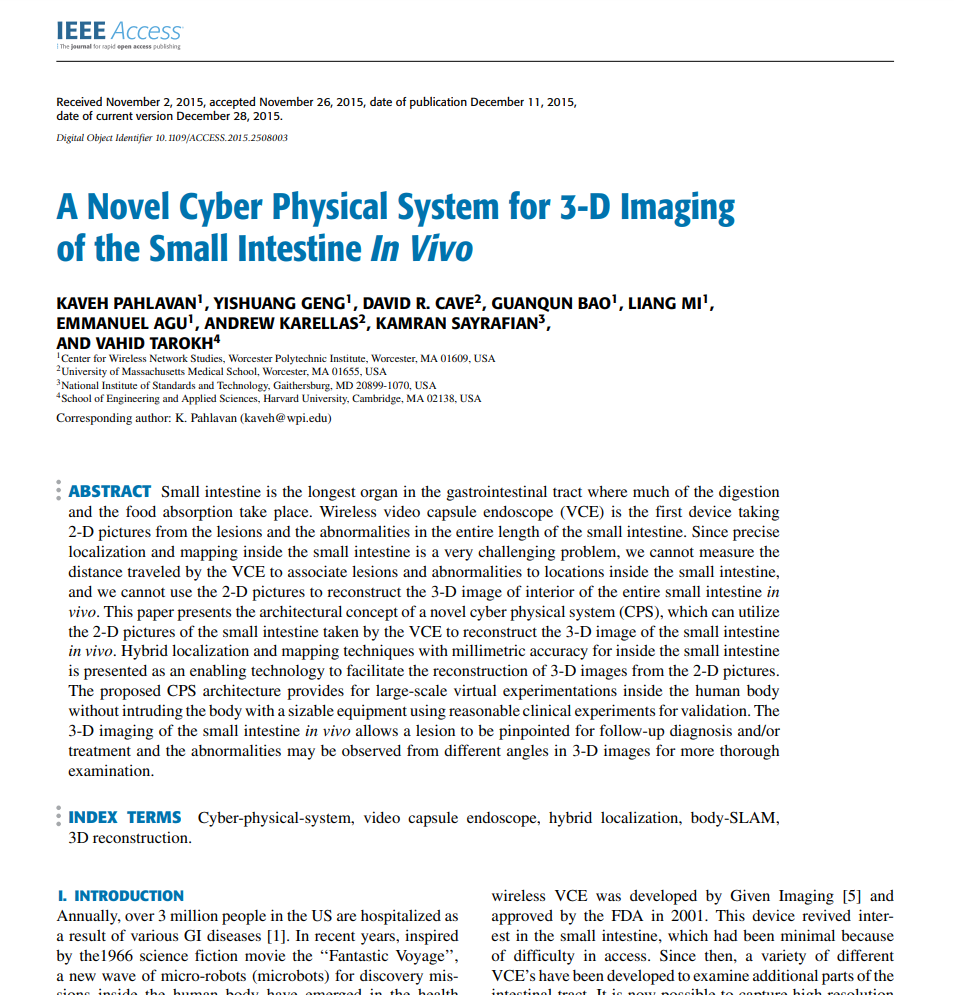Research Contributions:
Body Area Networks
Research in body area networks at CWINS started with channel measurement and modeling for wireless access and localization in and around the human body. The particular emphasis was on two applications, localization of wireless video capsule endoscope inside the small intestine and motion detection using RF signals transmitted from the sensors
IEEE Wireless Workshops
Brian Russell
CEO, Zephyr Technology
“Practicality of BAN for Physiological Monitoring and Various Applications”
John Hines
Center Chief Technologist, NASA Ames Research Center
“Body Area Networks and Wireless Medical Monitoring”
Kathy Chester
Senior Vice President Regulatory and Quality, St. Jude Medical’s
“Regulatory Challenges for the Wireless Health Industry”
Major Projects
Channel Measurement and Modeling for Body Area Networks (NIST/ARRA)Channel Measurement and Modeling for Body Area Networks (NIST/ARRA)
-
Principal Investigators
- Kaveh Pahlavan (CWINS)
- Jim Silverstrim (IWT)
Research Staff (CWINS)
-
- Yunxing Ye
- Guanqun Bao
- Yishuang Geng
- Umair Khan
- Jin Chen
- Zhuoran Liu
- Ruijun Fu
- Yi Wang
- Shen Li
- Jie He
- Liang Mi
Wireless capsule endoscope (WCE) provides a noninvasive method to examine the entire gastrointestinal (GI) tract including small intestine, which other video endoscopic instruments cannot reach. Since the shape of small intestine is extremely complex and the length of small intestine varies from 5 to 9 meters, localization of the WCE inside the small intestine is very challenging. Traditional radio frequency (RF) localization techniques using the received signal strength (RSS) are not able to provide satisfactory location information of the capsule inside the small intestine. In this project, we developped a hybrid localization technique that takes advantage of data fusion from image sequence captured by the WCE’s embedded camera and the RSS of the RF signal emitted by the capsule to enhance the positioning accuracy. This hybrid localization technique estimates the speed and direction of movement of the capsule by analyzing displacements of feature points between consecutive image frames and this motion information is integrated with RSS measurements by employing a Kalman filter to smooth the RF localization results.
Motion Detection Using RF Signals for the First Responder in Emergency Operations (UCLA/DHLS)
-
Principal Investigators
- Kaveh Pahlavan
Research Staff (CWINS)
-
- Yishuang Geng
- Jin Chen
The real-time health monitoring system is a promising body area network application to enhance the safety of fire fighters when they are working in harsh and dangerous environment. Except for monitoring the physiological status of the fire fighters, on-body monitoring network can be also regarded as a candidate solution of motion detection and classification. In this paper, a novel Support Vector Machine (SVM) classifier has been implemented using RF signals as classification features. The classifier is capable of detecting and classifying seven frequently appeared motions of fire fighters including standing, walking, running, lying, crawling, climbing and running up stairs. The average true classification rate of our classifier reaches 87.9175% and the effects of different human motions and sensor locations have been analyzed by plotting Receiver Operating Characteristics (ROC) curves.
Dynamic scenario on the 3rd floor of Atwater Kent Laboratory at WPI.
